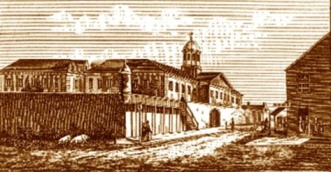Doctoral Student Jonathan Nash: Studying Prisons Through the Lens of History
 |
Doctoral student Jonathan Nash is studying Newgate and the early 19th century New York State prison system as a lens to examine crime, criminals, and imprisonment. (Photo Mark Schmidt) |
When the State Prison of the City of New York, commonly known as Newgate Prison, opened in 1797, it was modeled after a pioneering penal system in Pennsylvania. It wasn't long, however, before complex problems plagued Newgate, including overcrowding, a controversial pardon policy that resulted in inmates being released before serving their sentence, and a lack of services for the criminally insane.
Doctoral student Jonathan Nash is studying Newgate and the early 19th century New York State prison system as a lens to examine crime, criminals, and imprisonment; the thoughts and actions of early national reformers; and the lives of men, women, and children who were in jail.
"In my dissertation, I am examining how penitentiaries contributed to the re-imagining of physical, social, and temporal spaces, and to the processes that defined gender, class, race, and citizenship in the early nation," said Nash, 28, of Endicott, N.Y., who plans to become a college professor. He also plans to study Newgate's immediate successors, Auburn, built in 1816, and Sing Sing, built in 1828.
 |
The State Prison of the City of New York, commonly known as Newgate Prison, circa 1800. |
Nash has been given the means to continue his research through the award of a research fellowship from the Gilder Lehrman Institute of American History, which will cover the expenses of a two-week summer research trip to the Library of the New York Historical Society in New York City.
Richard F. Hamm, chair of the Department of History and a member of Nash�s dissertation committee, said, "Mr. Nash has an important topic, which he has approached with both diligence and originality. In studying the early prisons of New York, Mr. Nash is shifting focus from the reformers to the prisoners themselves. He has focused his work on the State Prison of the City of New York, the state�s first prison. He wants to recreate as much as their lives as he can, and use them as a means to explore the cultural construction of criminals, criminalities, and communities in this period (a period other scholars have quickly rushed past to explore later ones)."
Nash enrolled in UAlbany's doctoral program in history because of its innovative thematic orientation that trains students to become interdisciplinary scholars. The opportunity to work with distinguished faculty members in the English and History departments was also appealing.
The Gilder Lehrman Institute awards short-term fellowships to doctoral candidates, postdoctoral scholars, and independent scholars to conduct work in archives in New York City. Nash is one of 29 Gilder Lehrman Fellows for the first half of 2009. The Institute has funded 550 fellowships since 1994.
![]() For more news, subscribe to UAlbany's RSS headline feeds
For more news, subscribe to UAlbany's RSS headline feeds


